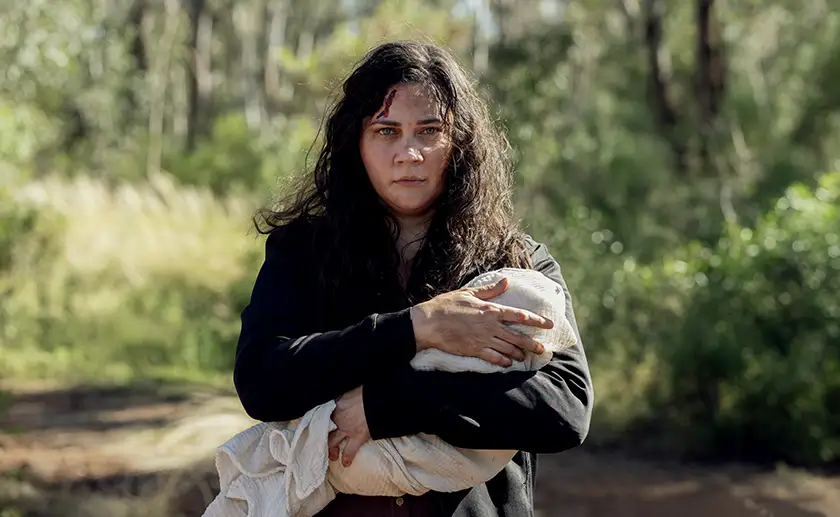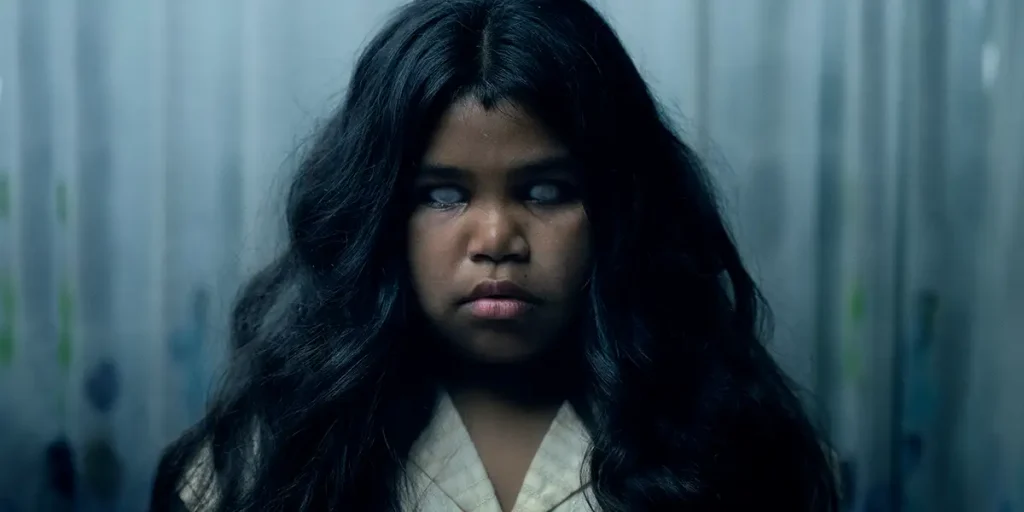In Jon Bell’s creepy feature-length debut The Moogai, an Aboriginal Australian mother is haunted by visions of a child-snatching creature.
Writer & Director: Jon Bell
Genre: Horror
Run Time: 86′
Rated: M
U.S. Release: May 9, 2025
U.K. Release: TBA
Where to Watch: In select US theaters
The Moogai wastes no time in establishing context. Between 1910 and 1970, its epigraph tells us, the Australian government ordered the removal of Aboriginal children from their communities, to be integrated into white foster homes in an attempt to ‘breed the colour’ out of the population. Indigenous director Jon Bell, adapting his own 2020 short of the same name, explicitly addresses this dark chapter of Australian history in his intriguing new indie horror.
But what is a ‘moogai’? Another early title card offers three definitions of the Bundjalung word: spirit, entity; Bogey Man; stealer of children. There’s no ambiguity in this premise that has served the horror genre well over the years; something is out there destroying families and causing unspeakable trauma, but its true face could be more human than we’d like to believe.
It’s indigenous mother of two Sarah (Shari Sebbens) who must contend with the threat, and legacy, of child abduction, be it perpetrated by spirits, humans, or both. When we meet her, she is a hotshot lawyer about to give birth to her second child while struggling to build a relationship with her own biological mother, Ruth (Tessa Rose). Though Sarah is too young to belong to the aforementioned ‘Stolen Generations’, she was nonetheless raised by a white family, the authorities having deemed Ruth unfit to care for her – whether they were right to do so is left open to interpretation.

The childbirth is a difficult one, and while the baby is born healthy, the doctor warns husband Fergus (Meyne Wyatt) that the experience could have a serious mental impact on Sarah. That’s when her nightmares and hallucinations, including a terrifying young girl with all-white eyes and a pair of skeletal hands reaching for her newborn, begin. Exhausted and overwhelmed, Sarah begins to lose her grip on reality, her experiences of the potentially supernatural compounded by run-ins with school teachers, the police and well-meaning white acquaintances that begin to doubt her fitness as a parent. Is their concern well founded, or is generations-old prejudice at play?
While the script can be somewhat on the nose in its social messaging – a clunkily written early interaction between archetypal girlboss Sarah and a sexist male colleague warns us of that – DP Sean Ryan’s use of colour and contrast serves as a more sophisticated expression of the film’s social dynamics. Sarah lives in a swish apartment full of sterile modern furnishings and a washed-out colour palette that matches the plain clothing of her adoptive parents; the early scenes are so brightly lit and low in contrast the white characters almost blend into the background. Ruth, on the other hand, barges into this bland environment adorned in vivid earth tones and carrying all manner of traditional trinkets and remedies. As well as the visual disparity, Sarah’s disapproval of such ‘superstition’ belies a distance between mother and daughter, and between our protagonist and her cultural roots.
Only in the film’s climax, when the family is forced out of the city and must confront the entity that has been haunting them, does Sarah begin to commune with nature and embrace Ruth’s folk traditions, whose efficacy seems more convincing as the supernatural occurrences continue. When the moogai finally reveals itself – an impressively unnerving monster design – amidst a ferocious nighttime blaze, the chiaroscuro of the black of night with the rich orange flames is beautifully rendered, the antithesis of that brightly lit homogeneity of earlier scenes.
Less impressive is the narrative direction of the film, which keeps things frustratingly linear, from the admittedly tantalising premise through to a predictable denouement. In the end, the parallel between the spectre of the moogai and the real horror of Australia’s past, unsubtle from the off, doesn’t amount to much in terms of political interrogation, acting more as a springboard for its characters’ paranoia. This is no crime, but the film’s difficult relationships and resulting catharsis aren’t especially well sold by its cast, who offer serviceable performances but no real emotional punch. The film therefore mines neither its sociopolitical context nor its questions of family and motherhood in great depth.
The Moogai seems to form part of a burgeoning wave of postcolonial horror cinema reckoning with the past by blending old folklore with more recent collective trauma; the recent, similarly flawed Fréwaka comes to mind. It is exciting to consider the breadth of histories and mythologies to explore through these works, but while the location, language and cultural context may change, formally speaking there is regretfully little to differentiate The Moogai from any other generic frightfest. Nonetheless, it is a competently made feature-length debut and a clear labour of love, with some memorably eerie imagery to boot.
The Moogai: Movie Plot & Recap
Synopsis:
Sarah, an Aboriginal Australian woman raised in a white family, grapples with dark visions following a difficult childbirth, which her biological mother claims is the child-snatching moogai at work. As the supernatural threat becomes more real, she struggles to be believed by others, and is forced to reconnect with her roots in order to protect her newborn child.
Pros:
- A fascinating premise covering a chapter of history unfamiliar to many
- Effective cinematography and set design highlight the characters’ disconnect
- Some genuinely creepy imagery
Cons:
- A disappointingly linear plot
- Clunky dialogue
- Unremarkable performances from the cast
The Moogai will be released in select US theatres on May 9, 2025.

